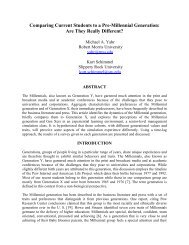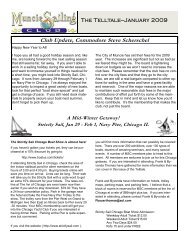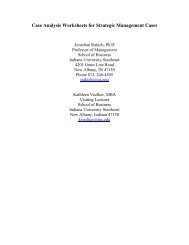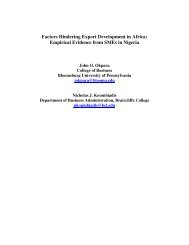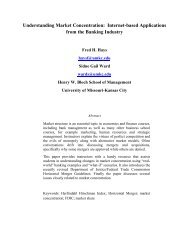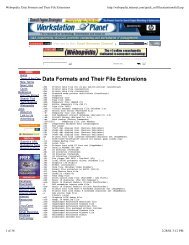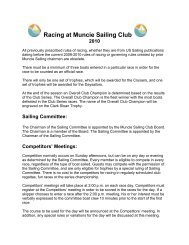Active versus Passive Management of International Mutual Funds ...
Active versus Passive Management of International Mutual Funds ...
Active versus Passive Management of International Mutual Funds ...
Create successful ePaper yourself
Turn your PDF publications into a flip-book with our unique Google optimized e-Paper software.
Efficient market hypothesis<br />
In 1970, Fama published the EMH theory. The theory is concerned with whether or not<br />
stock prices fully reflect all available information. The weak form <strong>of</strong> the EMH theory tests<br />
historical information and is fairly well supported. The semi-strong form tests all publicly<br />
available information. The strong-form tests whether or not advantages can be gained by<br />
insiders. As stated earlier, the weak form is fairly well supported, as is the semi-strong form.<br />
Support for the strong-form is not as well documented [35]. If one believes in the EMH, then one<br />
would believe that mutual fund managers cannot beat the market, and should therefore invest in a<br />
passive index.<br />
Treynor and Black [83] contributed to the debate regarding ownership <strong>of</strong> the index or<br />
seeking active management. Their question was whether or not a manager should balance<br />
underpriced long securities positions and underpriced short securities positions or should the<br />
portfolio be diversified until only market risk remains. In their model, they assume that security<br />
analysis can improve the performance <strong>of</strong> the portfolio. They conclude that it is useful to<br />
rebalance a portfolio. A portfolio consists <strong>of</strong> three parts: a riskless part, a diversified part, and an<br />
active part. The active part will depend upon security analysis and be independent <strong>of</strong> the active<br />
index [83].<br />
Origin <strong>of</strong> index funds<br />
Samuelson [70] restated that most money managers would not outperform the market. If<br />
they do, their returns are reduced by the transaction costs making it more appropriate to hold a<br />
specifically weighted segment <strong>of</strong> the market. The thinking, therefore, was to emulate the market<br />
with an index fund [70].<br />
Ellis [30] reiterated the call <strong>of</strong> Samuelson [70] to form index funds, as he could not find a<br />
group <strong>of</strong> managers that would consistently beat the market. Since individuals continue to believe<br />
they can beat the market, active management will continue as a concept <strong>of</strong> one’s self-esteem and<br />
self-worth. He termed investing in the market a “Loser’s Game,” as the more you tried to win the<br />
better chance you had to lose. He did not state that the evidence led to a passive or index fund,<br />
but the null hypothesis was hard to disprove [30]. Bogle took the challenge and started the first<br />
index fund in 1975, called the Vanguard 500 index trust. The fund started with $11 million under<br />
management and by 1995 reached $18 billion [19].<br />
Transaction costs and benchmark measures<br />
Ambachtsheer and Farrell [3] found that successful active management is not dependent<br />
on any specific valuation method. They found that successful active management is dependent<br />
on the ability to make judgments with predictive content that can be placed into unbiased<br />
valuations. The managers must then deal with the transaction costs and risk control. The use <strong>of</strong><br />
computers in providing the processing needs was essential [3].<br />
Lehmann and Modest [59] argued that it was necessary to have a benchmark for normal<br />
performance. The usual proxy for the market portfolio was the Capital Asset Pricing Model<br />
benchmarks. In their research they utilized the Arbitrage Pricing Model. The study examined 130<br />
mutual funds from January 1968 through December 1982, finding considerable differences<br />
between the performance measures given by the Capital Asset Pricing Model and Arbitrage<br />
Pricing Model benchmarks. The importance <strong>of</strong> the study indicated that knowing the benchmark<br />
was critical when comparing mutual fund performance [59].<br />
Essayyad and Wu [32] conducted a study that compared the performance <strong>of</strong> 18<br />
international mutual funds as identified in Wiesenberger Investment Company Services. Their<br />
study addressed the period from January 1, 1977 to June 30, 1984. Previous studies incorporated<br />
8



